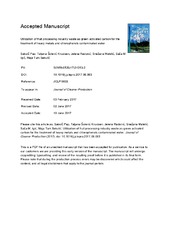Prikaz osnovnih podataka o dokumentu
Utilization of fruit processing industry waste as green activated carbon for the treatment of heavy metals and chlorophenols contaminated water
| dc.creator | Pap, Sabolc | |
| dc.creator | Šolević Knudsen, Tatjana | |
| dc.creator | Radonic, Jelena | |
| dc.creator | Maletić, Snežana | |
| dc.creator | Igic, Sasa M. | |
| dc.creator | Turk Sekulić, Maja | |
| dc.date.accessioned | 2019-06-05T05:24:12Z | |
| dc.date.available | 2019-06-12 | |
| dc.date.issued | 2017 | |
| dc.identifier.issn | 0959-6526 | |
| dc.identifier.uri | https://cer.ihtm.bg.ac.rs/handle/123456789/2133 | |
| dc.identifier.uri | https://cer.ihtm.bg.ac.rs/handle/123456789/2942 | |
| dc.description.abstract | Plum stones, as a part of industrial and municipal organic waste, were used as a precursor for preparation of a low-cost activated carbon. Engineered, thermochemically-modified adsorbent was used to remove lead (Pb2+), cadmium (Cd2+), nickel (Ni2+) and chlorophenols from an aqueous solution. The characterization of the medium was performed using standard instrumental analysis. Additionally, the assessment included the influence of pH, adsorbent dosage, temperature, contact time and initial metal concentration on the separation efficiency in the batch-operational mode. With optimal working conditions, the process efficiency of over 95% was accomplished. The equilibrium and kinetic studies of adsorption were done. The pseudo-second order model described the adsorption kinetics best. The maximum adsorption capacity of the engineered adsorbent for Pb2+, Cd2+ and Ni2+ ions was calculated from the Langmuir isotherms and found to be 172.43 mg g(-1), 112.74 mg g(-1) and 63.74 mg g(-1), respectively. Preliminary results indicate a strong affinity of the separation medium for chlorophenols. Thermodynamic parameters such as Gibbs energy, enthalpy and entropy were calculated. Regeneration of the saturated adsorbent was conducted, with diluted phosphoric acid produced as a waste stream, during the washing of the adsorbent after activation. Based on the desorption study results, the activated carbon was successfully regenerated in 3 cycles. Mutual influence of ions was analyzed in multicomponent systems. The real system production and operational costs analysis confirmed a possibility for a successful implementation of the highly efficient, eco-friendly engineered adsorbent in the field of cost-effective wastewater treatment. | en |
| dc.publisher | Elsevier Sci Ltd, Oxford | |
| dc.relation | info:eu-repo/grantAgreement/MESTD/Integrated and Interdisciplinary Research (IIR or III)/46007/RS// | |
| dc.relation | info:eu-repo/grantAgreement/MESTD/Basic Research (BR or ON)/176006/RS// | |
| dc.relation | TEMPUS project NETREL ("Network for education and training for public environmental laboratories") | |
| dc.relation | European Union, Brussels, Belgium | |
| dc.rights | embargoedAccess | |
| dc.rights.uri | https://creativecommons.org/licenses/by-nc-nd/4.0/ | |
| dc.source | Journal of Cleaner Production | |
| dc.subject | Activated carbon | en |
| dc.subject | Green technology | en |
| dc.subject | Wastewater treatment | en |
| dc.subject | Heavy metal | en |
| dc.subject | Chlorophenol | en |
| dc.subject | Plum stone | en |
| dc.title | Utilization of fruit processing industry waste as green activated carbon for the treatment of heavy metals and chlorophenols contaminated water | en |
| dc.type | article | |
| dc.rights.license | BY-NC-ND | |
| dcterms.abstract | Секулиц, Маја Турк; Пап, Саболц; Игиц, Саса М.; Малетиц, Снезана; Шолевић Кнудсен, Татјана; Радониц, Јелена; | |
| dc.citation.volume | 162 | |
| dc.citation.spage | 958 | |
| dc.citation.epage | 972 | |
| dc.citation.other | 162: 958-972 | |
| dc.citation.rank | aM21 | |
| dc.description.other | This is a peer-reviewed version of the article: [https://dx.doi.org/10.1016/j.jclepro.2017.06.083] | |
| dc.description.other | [http://cer.ihtm.bg.ac.rs/handle/123456789/2133] | |
| dc.identifier.doi | 10.1016/j.jclepro.2017.06.083 | |
| dc.identifier.fulltext | https://cer.ihtm.bg.ac.rs/bitstream/id/7192/0406_8.pdf | |
| dc.identifier.scopus | 2-s2.0-85024094057 | |
| dc.identifier.wos | 000407185500084 | |
| dc.type.version | acceptedVersion |


